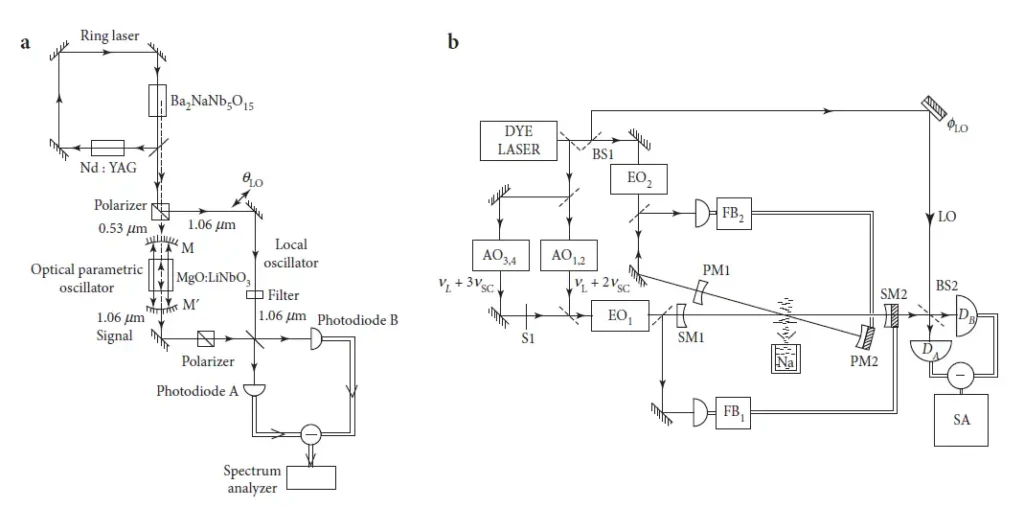
Engineering Photonic molecules for enhancing squeezed state of light
Photonic molecules have become an intriguing and relevant research area for integrated photonic systems. Photonic molecules act similarly to molecules in physical systems. Photonic molecules can be generated in a laboratory using micro-resonators. Micro-resonators exhibit special features that make them suitable for usage in integrated photonic devices. Engineering photonic molecules includes accurate lithography of micro-rings resonators with a desired gap, radius, roughness and dimension. Engineering photonic molecules has great challenges both in laboratory and theory and requires extensive knowledge of material engineering, photonics, physics as well as highly advanced equipments which are super expensive and require skilled operators. Therefore, in order to achieve an enhanced squeezed state of light, we need an accurate engineering of photonic molecules.
Squeezed states in nonlinear process
Squeezed states of light is a phenomenon in quantum photonics. The electric field strength of light for some phases has a quantum uncertainty smaller than that of a coherent state, which is referred to as squeezing. To obey Heisenberg’s uncertainty relation, a squeezed state must also have phases at which the electric field uncertainty is anti-squeezed, i.e., larger than that of a coherent state. Squeezing is a technique that helps improve the measurement sensitivity of properties at nature’s tiniest scales. It is used to reduce the uncertainty, or noise, of one measurement while increasing that of the other. Squeezing was first introduced in the pioneering works of Slusher (1985) and Wu (1985) via two different nonlinear optical processes as four wave mixing (FWM) and spontaneous parametric down conversion (SPDC) respectively.

Why is squeezing important in quantum photonics?
Universal quantum computers must be fault-tolerant in order to perform any desired computation. Fault-tolerant quantum computers are composed of Qumodes which need to be squeezed up to a certain level. The stability of squeezed Qumodes are also another important parameter which we have covered in the “Squeezing as an obstacle in fault tolerant quantum computers”. The question here arises is to which level of squeezing one can ensure to have a fault tolerant quantum computer?
How does the state of light get squeezed in a nonlinear medium?
In a nonlinear medium, the state of light gets squeezed by using certain optical nonlinear interactions.The nonlinearity in the medium helps to create squeezing by allowing the electric field strength of light to be modified in a way that it has a smaller quantum uncertainty than that of a coherent state. This is achieved by using certain optical nonlinear interactions, such as an optical parametric amplifier with a vacuum input which can generate a squeezed vacuum with a reduction in the noise of one quadrature component.
PIC researchers use nonlinear micro-resonators in order to trap light and create squeezed states of light. In the following we’ll discuss what micro-resonators are and their important features in detail.
Micro-resonators in photonic integrated circuits
Micro-resonators are a key component of photonic integrated circuits (PICs) that have revolutionized the field of photonics. They are tiny structures that can trap light in a small volume, allowing for the manipulation of light at the nanoscale level. Micro-resonators are used in a variety of applications, including optical filters, modulators, and biosensors. Micro-resonators have several advantages over traditional optical components. They are compact, lightweight, and can be integrated with other optical components on a single chip. This makes them ideal for use in applications where space is limited, such as in quantum computing devices.
Nonlinear Micro-rings resonators
Nonlinear micro-rings are a type of cavity in microscale level with high finesse and adjustable FSRs. Despite bulk optics which use mirrors and dichroic mirrors to establish a cavity and are too sensitive to environmental noises, micro-rings are well designed to resist the external noises. Nonlinear micro-rings are often created by direct-write lithography on variant wafers such as Silicon, Lithium Niobate among other proper candidates.
Squeezed states of light in micro-ring resonators
Squeezed state of light is the result of resonating light in nonlinear micro-ring resonators with proper phase match. Light in a resonator will be squeezed When phase matching is satisfied to be DPDC or FWM. Squeezing level of light is in direct relation with the amount of time spent inside the micro-cavity. In a more comprehensive manner, higher quality factors will help the photons to stay longer inside micro-cavity and hence produce a higher squeezing level. In order to reach a state with a desired squeezing level, precise engineering together with a proper fabrication is vital. If you have followed the process of squeezing state of light with micro-ring resonators, you can also read our innovative research on “Innovative enhancement of squeezing in photonic molecules”.
3 Comments
-
-
samuel
Interesting article. I'm waiting for your group article about enhancement of squeezing.



Rian
Could you write an entire article about '' WHY IS SQUEEZING IMPORTANT IN QUANTUM PHOTONICS?''